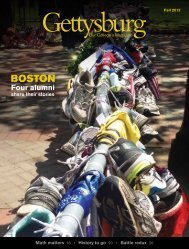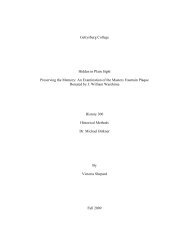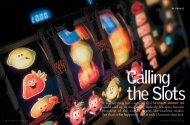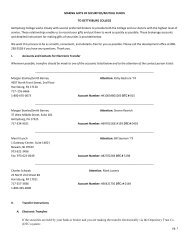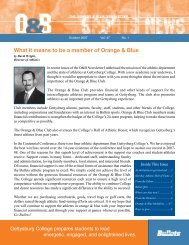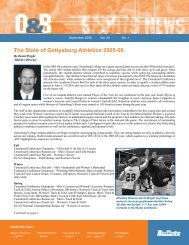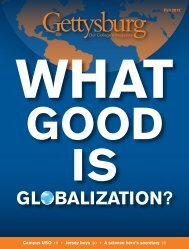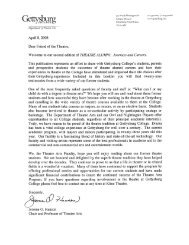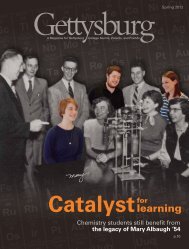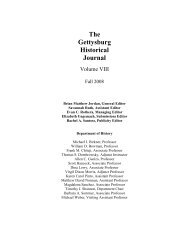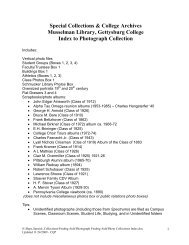157 North Washington Street Paper - Gettysburg College
157 North Washington Street Paper - Gettysburg College
157 North Washington Street Paper - Gettysburg College
Create successful ePaper yourself
Turn your PDF publications into a flip-book with our unique Google optimized e-Paper software.
The <strong>College</strong>’s antagonism of the emerging fraternal scene began to soften after the<br />
<strong>College</strong> Monthly in 1887 ran quotes from Andrew White, then President of Cornell University,<br />
in which he defended the secret societies by employing a logic which Glatfelter explains as,<br />
“Wipe out the fraternities and some other “cliques, clubs, parties, and intrigues” will take their<br />
place.” 6 The <strong>College</strong> subsequently allowed one or two members of each fraternity to attend their<br />
national convention, yet maintained only a vague catalogue reference to “Greek letter societies”<br />
which had begun to build meeting houses on campus. 7 These meeting houses became essential as<br />
rising membership in each fraternity made the confines of a member’s dorm room a less than<br />
ideal arena for chapter meetings. Indeed, the <strong>College</strong> Spectrum of 1899 estimated that 417 out of<br />
a graduated total of 1,068 men had been members of a fraternity. This 39% Greek campus of<br />
over a century ago nearly rivals the 2005 <strong>College</strong> statistics of a 43% Greek rate and demonstrates<br />
the need which initiated the construction chapter houses. 8<br />
It was out of this need that in 1904, ATO followed four other fraternities and laid the<br />
cornerstone for its chapter house on <strong>North</strong> <strong>Washington</strong> <strong>Street</strong> on a lot it had purchased for $7500<br />
from a local real estate entrepreneur. 9 As Glatfelter states, by 1904 fraternities “had won their<br />
battle for recognition and were already establishing themselves as formidable centers of student<br />
power and alumni loyalty.” 10 Accordingly, fraternity chapter houses, which had been one story<br />
structures consisting of one or two meeting rooms, began to be replaced by the construction of<br />
dormitories in which “with faculty and trustee permission, members ate, slept, and otherwise<br />
lived together.” 11 The original ATO house, located directly across from what was the college’s<br />
main entrance, was as Elwood Christ describes it in the building’s Historical Resource Survey<br />
Form, was a “three-story, brick, Sullivanesque styled structure. The first story porch, recessed<br />
under the upper stories was accented by ogee or flattened gothic arches . . . the front of the roof .<br />
3



